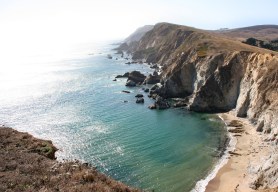

For his survival expeditions and TV shows, Bear Grylls has spent time in some of the world’s most inhospitable landscapes, and this includes deserts. He says he has been in the world’s toughest and that they are “brutal, unforgiving wildernesses to be in.” He also says that a really hot desert will kill you faster than any other terrain—sometimes within a few hours.
Videos by Outdoors
Bear’s first secret to surviving in a desert is good planning, so that you don’t end up in a desert without food, water, and shelter. If you do find yourself in a survival situation, finding shelter is key.
Avoid Overheating
Protection from heat is vital. Bear says that overheating can be as lethal as freezing, so you need to find shelter from the sun and solar radiation.
“Dehydration and sunburn are potential killers and a rise of just 3.5°C (38°F) in the body’s core temperature will lead to heat stroke,” says Bear in Born Survivor. In the desert, you will need to find shelter from both the cold and the heat. Temperatures can be 65°C (149°F) during the day, but below freezing at night. “Death from exposure in the desert is common,” he says.
Shelter for your Skin

The first rule is to use your clothing to protect your head, neck, skin, and eyes while you find shelter. Keep yourself covered up but keep clothing loose—and cover your head with a hat, scarf, t-shirt, or any other material.
“Urinating on the head dress will also help keep you cool,” says Bear in How to Stay Alive. “I
have had to resort to this many times! Pull your head dress across your face as well to protect it from the sun.”
Find Natural Shade
The next thing that you need is shade from the hot sun. Look for a place where there is a simple form of shelter, before you use up your vital energy or get dehydrated building one from scratch.
You will need some sort of roof, and this could be anything from a rocky outcrop to shade from a giant cactus. Trees and bushes will give more protection from the sun during the day than rocks, which might store heat and then allow it to radiate out. However, this heat can be an advantage at night. It can also be an advantage if the rocks are hot enough to use as a surface for cooking food.
“Whilst in the Moab Desert, the rocks were so hot that I used one to fry a raven’s egg I had found. It was sizzling within two seconds!” says Bear in Born Survivor.
Make an Improvised Shelter

Use whatever material you have—whether it’s a tarp, a piece of parachute, a coat, a blanket, or a sleeping bag—for protection from the hot sun. You can drape the material across natural features like a rock or bush. Small trees and bushes are good for shade or for the materials to make a lean-to or a-frame shelter.
Shelter in a Cave or Overhang
Caves and overhangs also make great shelters, and they often have a slight incline or space to allow air to circulate. Remember, though, that you might not be the only creature looking for shade. Beware of snakes, spiders, scorpions, or mountain lions that might be using the same desert features to survive.
Building a Shelter

If you decide to build a shelter, do any building work early in the morning or late in the evening, when you have enough light but the temperatures are not too hot. On level terrain, you can make a scrape shelter. If you can find a natural feature that is casting a shadow, dig the scrape shelter on the shady side.
Dig down into the sand and then spread a sheet or tarp over the hollow. You can put rocks around it to keep it in place. If you have a second sheet, make a double layer to reduce the temperature even further.
On the bottom, make a platform of vegetation from roots and branches. This will protect from the heat of the desert floor and also from the cold during the night.
Stay with Your Car or Vehicle
Finally, if your vehicle breaks down, the safest option is to stay with it, as you will be easier to find—both on the ground and in the air. Don’t stay in the car, which will be too hot during the day and too cold at night, but use the shade from it and dig down into the ground under it, which will be cooler.
The same concept goes for the wreckage of an aircraft or other vehicle. Use the shade that it casts or use it for support to build a shelter.
What other tips would you add?









